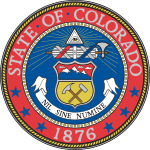| |||||||||||||||||
| |||||||||||||||||
 County results Allott: 40-50% 50–60% 60–70% Knous: 50–60% 60–70% | |||||||||||||||||
| |||||||||||||||||
| Elections in Colorado |
|---|
 |
The 1960 United States Senate election in Colorado took place on November 8, 1960. Incumbent Republican Senator Gordon Allott was re-elected to a second term in office, defeating Democratic Lieutenant Governor Robert Lee Knous.

